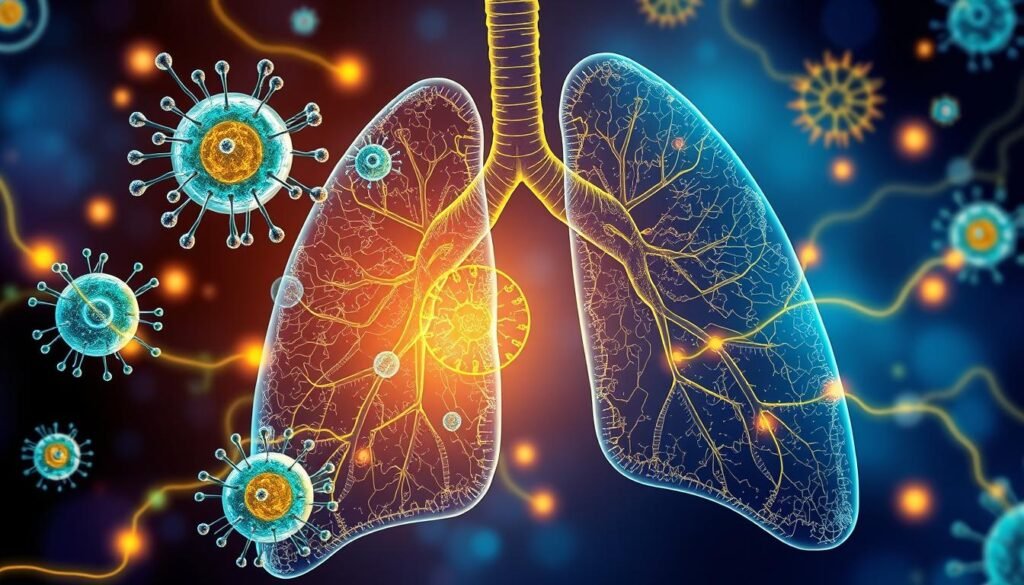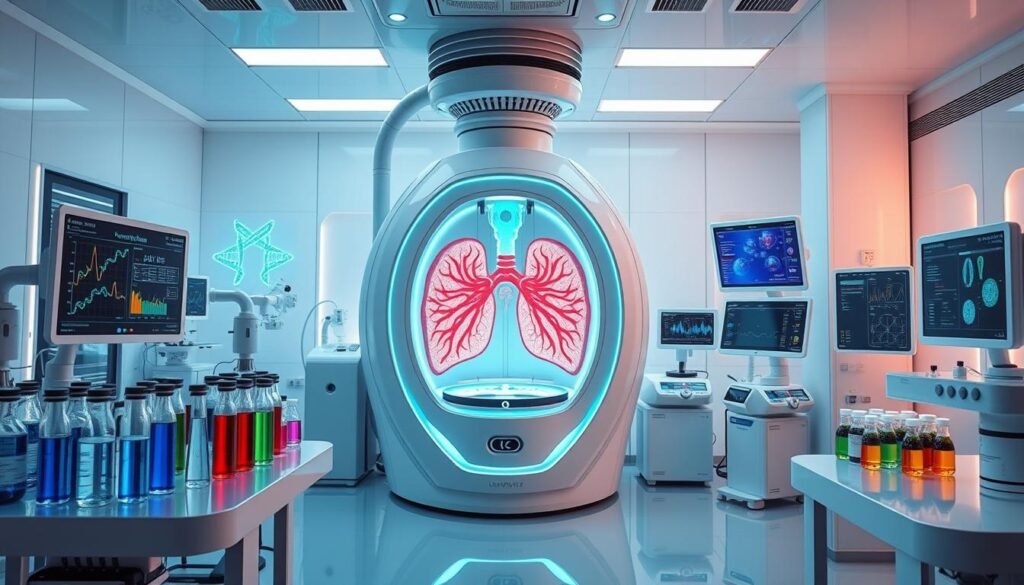Lung cancer is the top cause of cancer-related deaths around the world. Non-small cell lung cancer (NSCLC) makes up about 85% of all cases. This fact underlines the critical need for new therapies. Especially for those in advanced stages of the disease. The effort now focuses on the latest treatments that are tailored to individual needs.
Once, lung cancer treatments were more basic. But now, we have more effective options. Things like targeted therapies and immunotherapy are changing patient care. They improve survival rates and are tailored to the genetic make-up of tumors. They also boost the body’s immune system to fight cancer.
This piece will look into new therapies for advanced stage lung cancer. We will uncover breakthroughs that are changing treatment and offering hope to patients everywhere.
Key Takeaways
- Lung cancer is the leading cause of cancer death globally, with NSCLC being the most prevalent subtype.
- Innovative therapies are rapidly evolving, focusing on personalized and targeted treatments.
- Immunotherapy and targeted agents are at the forefront of advanced lung cancer treatments.
- Progress in tumor molecular profiling enhances the effectiveness of treatment options.
- Clinical trials are crucial for developing and validating new therapies.
Understanding Advanced Stage Lung Cancer
Advanced stage lung cancer mostly refers to non-small-cell lung cancer (NSCLC) that has spread far. It often leads to metastasis in distant parts of the body. To grasp this stage, experts use Lung Cancer Staging. They look at tumor size, lymph node status, and whether it has spread. This helps in choosing the right treatment.
Some common Symptoms of Lung Cancer are a persistent cough, chest pain, unexplained weight loss, and breathing issues. Spotting these signs early can change the treatment’s effectiveness. For those at higher risk, low-dose CT scans can spot cancer early. This allows for quicker treatment.
Getting to know advanced stage lung cancer helps in its management. It also shows possible treatment ways. Oncologists create custom treatment plans. They consider the cancer’s traits and the patient’s overall health. A broad strategy is key in fighting this complex disease.
Patients with advanced lung cancer go through different treatments. These include surgery, radiation, chemotherapy, and immunotherapy. Each method aims to lessen symptoms and boost life quality. They are adjusted to meet the patient’s specific needs.
Explore the staging guidelines and treatment options for advanced stage lung cancer.
Current Treatment Landscape for Lung Cancer
Lung cancer is the top cause of cancer deaths worldwide. Most lung cancer cases are non-small cell lung cancer (NSCLC), making up about 85% of diagnoses. Treatments include surgery, chemotherapy, radiation, immunotherapy, and targeted therapy.
New treatments have greatly improved survival for advanced NSCLC patients. Targeted therapies for specific genetic mutations have changed lung cancer care. Those without these mutations benefit from immune checkpoint inhibitors (ICIs), improving response and remission times.
Survival rates for NSCLC patients have risen over the last ten years. This is thanks to targeted therapies and immunotherapies. Drugs like nivolumab and pembrolizumab work better than older treatments like docetaxel.
Yet, treating lung cancer still faces hurdles. Patients with small cell lung cancer (SCLC) often have short survival times, despite treatment. Platinum-based chemotherapy remains crucial for them.
Clinical trials are key to advancing care. Studies are exploring how combining ICIs with chemotherapy could set new care standards. Care now emphasizes teamwork among healthcare providers, focusing on tailored treatments for each patient.
The current lung cancer care combines well-known and new methods. By focusing on personalized care and continuous research, we aim to further improve lung cancer patients’ survival and well-being.
| Treatment Type | Targeted Cancers | Mechanism of Action | Examples |
|---|---|---|---|
| Chemotherapy | NSCLC, SCLC | Interferes with cancer cell division | Cisplatin, Carboplatin |
| Targeted Therapy | NSCLC (with driver mutations) | Targets specific mutations | Erlotinib (EGFR), Crizotinib (ALK) |
| Immunotherapy | NSCLC, SCLC | Enhances immune response | Nivolumab, Pembrolizumab |
| Surgery | Resectable NSCLC | Removes tumor | Lobectomy, Pneumonectomy |
| Radiation Therapy | Localized lung cancer | Destroys cancer cells | Thoracic radiation |
Targeted Therapies for Lung Cancer
Targeted therapies mark a big change in treating lung cancer. They offer treatment based on a patient’s unique tumor genes. It’s crucial to know the mutations in a tumor to choose the best treatment.
Actionable Oncogenic Driver Mutations
About 5% of non-small cell lung cancers (NSCLC) have a change in the ALK gene. This change is common in non-smokers who have adenocarcinoma. The ROS1 gene rearrangement is found in 1% to 2% of NSCLCs. It often occurs in adenocarcinomas without ALK, KRAS, or EGFR mutations. Around 12.5% of NSCLC patients have the KRAS G12C mutation.
Finding these mutations through biomarker testing is key. This lets doctors give personalized therapies that can help a lot. For instance, patients with EGFR mutations might get EGFR inhibitors like afatinib (Gilotrif) or osimertinib (Tagrisso).
New Classes of Targeted Agents
New treatment agents focus on blocking specific mutations. KRAS inhibitors are one example, though they may cause diarrhea and muscle pain. Angiogenesis inhibitors, like bevacizumab (Avastin), are used with chemo or immunotherapy for advanced NSCLC.
Clinical trials are checking out these new agents. This could lead to more options for patients with certain genetic features. The approach to targeted therapies for lung cancer is constantly getting better. This gives hope to many people.

Innovative Lung Cancer Treatments
Recently, lung cancer treatment has seen a big change, moving towards more effective ways. Innovative Lung Cancer Treatments are now focusing on methods that overcome traditional hurdles. A key advancement is intrathecal chemotherapy with Ommaya reservoirs. This method delivers treatment directly to the cerebrospinal fluid. It helps manage leptomeningeal disease in lung cancer patients better.
Immunotherapy is now key in battling lung cancer, bringing a new phase in care. The Fred Hutchinson Cancer Center leads by tailoring treatments. They use new treatment options based on each patient’s unique cancer profile.
Proton therapy is another major leap forward. It reduces radiation exposure to vital organs. For lung cancer that hasn’t spread beyond the chest, this can be particularly effective. Such innovations have been associated with increased survival rates.
The use of new drugs and methods, like genetic analysis, has led to targeted solutions. For instance, repotrectinib has shown great results in patients trying it for the first time. Kathie Schultz’s story illustrates this. She saw her tumor shrink dramatically after chemotherapy and immunotherapy. This let her undergo successful surgery.
The ongoing exploration of these new strategies brings hope for lung cancer patients. They suggest a better future with improved survival rates and quality of life. It’s an exciting time in the fight against lung cancer.
| Treatment Type | Mechanism | Clinical Application | Response Rates |
|---|---|---|---|
| Intrathecal chemotherapy | Direct delivery to cerebrospinal fluid | Leptomeningeal disease | Promising efficacy |
| Immunotherapy | Enhances immune response | Advanced lung cancer | Higher survival rates |
| Proton therapy | Targeted radiation | Localized lung cancer | Reduced exposure to critical organs |
| Repotrectinib | Targeting ROS1 fusions | Advanced lung cancers with ROS1 mutation | ~80% in treatment-naïve, ~40% in pre-treated |
Advanced Stage Lung Cancer Therapies
New treatments for advanced lung cancer are now available. These breakthroughs give hope to those with a tough diagnosis. Ongoing clinical trials show that these options are getting better and more effective.
Overview of Current Breakthroughs
The latest in lung cancer care combines old and new methods. For the most common type, treatments include surgery, chemo, and newer targeted therapies. These are especially important for patients with certain genetic changes.
Clinical Trials and Future Direction
Lung cancer trials are key to finding new treatments. These studies test new drugs and their combinations. Some results show different survival rates based on cancer type and stage. For instance, advanced non-small cell lung cancer has a five-year survival rate of 8%. Early-stage cases do better, with rates of 37%.
Small cell lung cancer has tougher odds, with only a 3% five-year survival at its worst stage. Adding care for emotional and physical well-being can make a big difference for patients. This is essential during intense treatments.

| Cancer Type | Stage | Five-Year Survival Rate |
|---|---|---|
| Non-Small Cell Lung Cancer (NSCLC) | Metastatic Stage 4 | 8% |
| Non-Small Cell Lung Cancer (NSCLC) | Regional Stage 4 | 37% |
| Small Cell Lung Cancer (SCLC) | Metastatic Stage 4 | 3% |
| Small Cell Lung Cancer (SCLC) | Regional Stage 4 | 18% |
As studies look into fighting lung cancer’s resistance to treatment, it’s vital for patients and caregivers to keep up with new trials. These could offer new hope in the battle against this illness.
Role of Personalized Medicine in Lung Cancer
Personalized Medicine for Lung Cancer is changing how doctors treat the disease. It allows healthcare providers to create treatments that match each tumor’s genetic makeup. This approach uses the patient’s genetics and biomarkers to improve treatment.
Precision Oncology uses genetics to find the right treatments. Doctors look at mutations in lung cancer cells to pick the best therapies. For instance, crizotinib and ceritinib are approved for certain lung cancers because of specific mutations they target. This means doctors can choose medicines based on the cancer’s specific traits.
Advanced lung cancer often needs genetic profiling and biomarker tests. These tests find the best targeted therapies and allow for personalized risk assessments. They consider factors like smoking, age, and gender, helping catch cancer early and improve chances of survival.
Liquid biopsies are a step forward in personalized medicine. They help track the cancer’s changes, especially when it becomes resistant to treatment. This lets doctors change treatment plans quickly to get better results.

New tools in diagnostics are making personalized treatment more precise. For example, Dako Denmark’s HERCEPTEST and Myriad Genetic Labs’ BRACAnalysis CDx pick treatments based on a person’s cancer. With the Precision Medicine Initiative of 2015, there’s a strong move towards better personalized cancer care. These efforts mean treatment for lung cancer is becoming more tailored to each patient’s unique disease.
Latest Advancements in Lung Cancer Therapy
Lung cancer is the top cause of cancer death worldwide, making up about 13% of all cancer cases. In 2022, the American Cancer Society estimated 236,740 new lung cancer cases in the U.S. most of these were at an advanced stage. But, recent advancements in treatment like New Drug Developments are giving people hope.
One big step forward is the use of KRAS inhibitors, opening new doors in the fight against cancer. Treatments like pembrolizumab and nivolumab are also making waves. They work well even for those found early on. This shift towards early intervention is improving chances for patients.
For non-small cell lung cancer, which is 85% of cases, biomarkers are a game-changer. They’ve greatly improved survival rates. Targeted therapies are now crucial. They focus on the patient’s unique genetic makeup, making treatments more personal.
New combination therapies are being developed too. They use anti-VEGF pathway inhibitors like Bevacizumab to treat advanced NSCLC. These combos are more effective against tumors. Scientists are also looking into how miRNA plays a role in this process.
An important step was the FDA fast-tracking durvalumab for small cell lung cancer. This could help patients live longer. Also, seven countries are working on lung cancer vaccines. This is a big move towards preventing the disease before it starts.
With ongoing research, lung cancer therapy is constantly getting better. It’s providing new options for treatment and giving patients and their families new hope.
| Treatment Type | Mechanism | FDA Approval | Targeted Population |
|---|---|---|---|
| KRAS Inhibitors | Targeting specific mutations | Yes | KRAS mutant lung cancer patients |
| Immune Checkpoint Inhibitors | Enhance immune response | Yes | Advanced and early-stage patients |
| Biomarker Testing | Identifies targeted therapies | Ongoing studies | NSCLC patients |
| Combination Therapies | Synergistic anti-tumor effects | Yes | Advanced stage patients |
| Lung Cancer Vaccines | Boost immune response | In clinical trials | High-risk individuals |
Cutting-Edge Treatment Approaches
New treatments for lung cancer are changing oncology. This progress includes advanced therapies that improve detection and treatment plans. Now, all non-small cell lung cancer patients get a genetic test. This ensures they receive care that fits their needs.
The drug sotorasib (Lumakras™) was a big step in 2021. It was the first drug aimed at KRAS in non-small cell lung cancer. When caught early, up to 65% of patients can survive. This highlights how vital early detection and new treatments are.
New treatments use a mix of targeted drugs like ALK inhibitors and immune therapies. These include drugs that boost the immune system. Trials also look at how immune cells in the tumor work against lung cancer.
- Most early lung cancer surgeries now use a method called VATS. It’s less invasive.
- There are ongoing trials for lung cancer vaccines. They aim to stop cancer from coming back after surgery.
- Low-dose CT scans are key for early detection. They greatly boost survival chances for those at high risk.
There’s a wide-ranging approach that mixes new treatments and research. This is making the future brighter for lung cancer patients. The creation of new medicines adds hope and innovation to fighting cancer.
Emerging Trends in Lung Cancer Research
The field of lung cancer research is always changing. New findings show how crucial it is to understand the disease on a deeper, molecular level. Among these, Non-small cell lung cancer (NSCLC), which makes up 85% of all lung cancer cases. It is seeing major advancements, especially in how we detect and treat it. Adenocarcinoma, a common subtype, accounts for 38% of NSCLC cases and is a key area of study.
Scientists are looking into blood and sputum markers for early diagnosis and tracking treatment progress. This could revolutionize lung cancer care. Breakthroughs in understanding EGFR mutations, which 40% of NSCLC patients have, are leading to personalized treatment plans. Research on MET gene mutations is also offering new targeted therapy options, highlighting the value of molecular profiling.
New imaging techniques are changing the game as well. The use of 18F-FDG-PET/CT imaging helps in staging the disease and evaluating treatment options. This, along with new radiopharmaceuticals like 18F-FLT, is opening doors to better monitor how patients respond to treatments. Studies have shown that multi-tracer PET/CT imaging can even achieve 100% sensitivity in nodule characterization.
There’s also a growing interest in the immune system’s role in lung cancer. Studies on integrin-targeted RGD peptides are exploring tumor blood vessel formation. This might lead to innovative treatments. Despite this progress, screening rates for lung cancer are low, with only 16% of high-risk individuals screened in 2022. Boosting awareness for early detection is crucial, as survival rates have increased by 26% over five years.
Thanks to advanced research and a focus on tailored treatments, the outlook for lung cancer care is improving. A deeper grasp of lung cancer’s biology will improve both detection and the creation of targeted treatments. As research continues, the hope for significantly better outcomes for lung cancer patients grows stronger.
Conclusion
As we look back at the Summary of Advanced Lung Cancer Therapies, it’s clear that new treatments are changing things. Most lung cancer cases are non-small cell lung cancer (NSCLC). For patients with EGFR mutations, drugs like osimertinib are key. Yet, there’s still a big problem with the cancer coming back after surgery, which shows we need more research.
New findings in targeted treatments and drug combinations are exciting. Combining bevacizumab with chemo helps some patients live longer. Also, learning about genetic changes in cancer helps us find better treatments for each person. This is a big step towards Future Directions in Lung Cancer Treatment.
In short, even though lung adenocarcinoma is a big part of lung cancer cases, new treatments and research are vital for better results. By tailoring treatments and using the latest research, we can give hope to those fighting lung cancer. Together, we can make a difference in this tough battle.